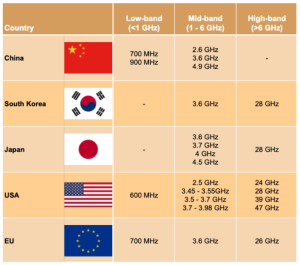Band profiles updated for 2023
Spectrum policymakers tend to think of their 5G strategies in terms of three pillars: low-band, mid-band and high-band spectrum.
In Europe, for example, the focus is on the 700 MHz, 3.5 GHz and 26 GHz bands. In other parts of the world, the picture is somewhat different. Japan and South Korea, for example, are not using sub-1 GHz spectrum for 5G yet.

Of these, it is really C-band spectrum that has done the heavy lifting so far. This is mainly due to the 100 MHz channels and above that can deliver 5G’s gigabits per second mobile broadband data rates.
The higher bands have not seen much use so far. Few European countries seem to be particularly interested in the 26 GHz band, while in South Korea, there have been mixed results in the 28 GHz band.
A second generation of mmWave frequencies will include the 40 GHz band, which WRC-19 identified for IMTInternational Mobile Telecommunications (I…. So far, only the US has issued licences, but several countries are considering awards.
And as 3G networks shut down around the world, the 2.1 GHz band has become a key target for upgrading to 4G/5G.
To find out more about which bands are being used for 5G around the world, and much more, check out PolicyTracker‘s band profiles. There is an overview here.
All band profiles have now been updated for 2023 and are available to Spectrum Research Service Subscribers.
Not a subscriber yet? For further information, including a brochure and data sample, please contact Martin Sims (martin [@] policytracker.com or +44(0)20 7100 2875) for a demonstration
